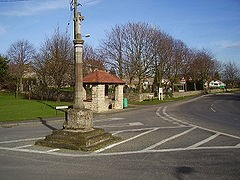
During the medieval period the parish was originally governed as part of the ancient Flaxwell Wapentake in the North Kesteven division of Lincolnshire. The name Cranwell is thought to mean the spring or stream frequented by cranes or herons.
The village centres on the remains of the village cross. The cross is a 14th-century market cross (or buttercross) from which important matters of public moment were announced. The cross, which is listed as a Grade 2 scheduled monument, had restoration work carried out by a Mr CH Fowler between 1911 and 1912.
More information about the Village Cross can be found by CLICKING HERE to go to this page on our site.
Cranwell manor was held by the Thorold family from the 16th century for over three hundred years. The manor house was demolished in 1816 and the Hall Farm's farmhouse was erected on the site. The Thorold family moved to a new mansion at Syston Park. In 1871 Sir John Thorold is recorded as owning all the land in Cranwell with the exception of the church, Glebelands and a single farmstead that was under the ownership of St. John’s College, Cambridge.
In 1682, Sir William and his wife Lady Anne Thorold are recorded as establishing a charity that gave about £8 and 2 shillings (£8.10) per year for the poor, to be distributed on Lady Day (25 March and then considered to be New Year's Day). The parish also benefited from the will of Lady Margaret Thorold who granted £15 a year to apprentice four boys from the village. With the Poor Law Amendment Act reforms of 1834, the parish probably became part of the Sleaford Poor Law Union group of parishes.
The population of the village in 1801 was recorded as being just 88 people and even by 1911 had only risen to 184. The village only grew and has continued to expand since the opening of the aviation training facility and now stands in the region of 3,000 residents (2011 census).
Cranwell railway station, on a single track branch-line from Sleaford, opened in 1917 and served the naval aviation training facility then known as RNAS Daedalus, later to become RAF Cranwell. The branch line was closed in 1956 and the track removed. However, the original station building still stands and is in use as the current RAF main guardroom. Engine sheds in a small goods yard area closer to the village were demolished and the land re-used for housing.
Standing near to the cross is the village's parish church dedicated to St. Andrew, the church originates circa the 10th century, the village possibly dates from the time of King Alfred (849-899). The church consists only of a nave and chancel with, above the former, a bellcote, much of the masonry is Norman but parts date back to Saxon times. The fittings include 17th century bench-ends and a Perpendicular Rood Screen.
Mounted on corbels in the north aisle are the remains of a hogsback grave. The carvings on these stones are either Saxon or Norse Ringerike. The stones are unique to Lincolnshire and are probably the finest of their type in the country. In the stonework in the porch is the incised outline of a pilgrim’s shoe and the year 1728, and on the right-hand door pillar are six carved figures believed to depict ancient May King and Queen ceremonial costumes. The churchyard includes a Commonwealth Graves Commission Cemetery with 131 graves from First and Second world Wars.
As early as 1682, Sir William and Lady Anne Thorold funded a charity that provided £3 each year for the education of poor children from within the parish. The first true school built in Cranwell opened in 1850 by public subscription and provided facilities for up to 35 children.
The current Cranwell Primary School is housed in a modern building and has approximately 345 children on the roll between the ages of 4 - 11. The school is a Foundation school and is non-denominational.
There are no secondary schools in the village and children instead travel to Lincoln, Grantham or Sleaford.
Cranwell does not have a public house. It does, however, have a members only social club. This dates back to when the cadets training at RAF Cranwell during the Second World War used to come into the village to try and buy alcohol. The members only club was introduced as a deterrent to them, being only temporary residents in the area they were therefore unable to gain membership. To this day, no pub has ever opened its doors to the public, even though the reasons for not having one have long since become obsolete.
